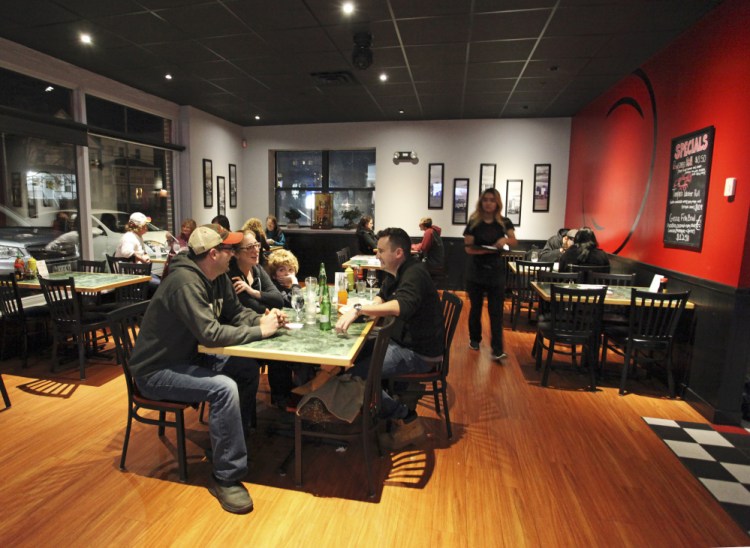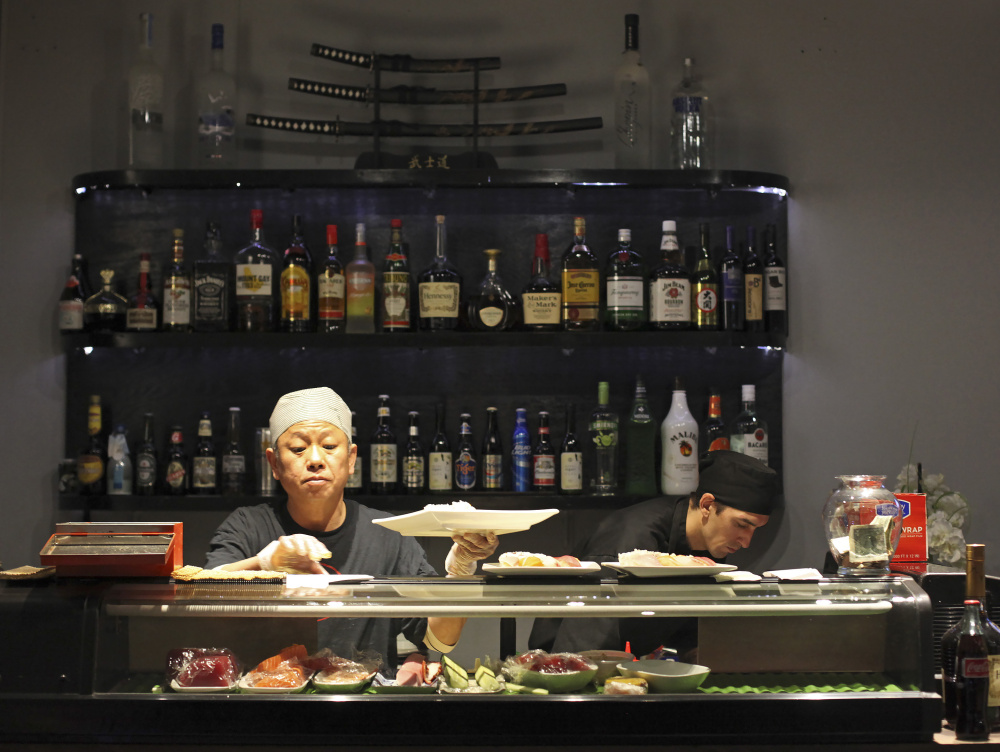If we take Tennyson at his word and buy his claim that the spring is when a young man’s fancy lightly turns to thoughts of love, then what happens in winter? Forget love – in the colder months of the year, it’s all about hot pot.
Go pretty much anywhere in East and Southeast Asia at this time of year, and you’ll find people sitting around tables, orbiting portable gas burners that prop up bubbling pots of broth. Call it “shabu shabu” or “nabemono,” as the Japanese do; “suki” (Thai); “huo guo” (Chinese); or simply “hot pot,” it’s remarkably similar across the continent. Dinner (or lunch, or a snack) is all about dipping bite-sized pieces of vegetables, noodles, fish and meat in simmering soup to cook, then ladling them out into individual bowls along with a helping of the steaming broth.
Eating hot pot is not only a great way to stave off the season’s chill, it’s also an intensely social, communal way of eating. At the same time, it accommodates preferences and dietary needs seamlessly: You select the ingredients that go in, and you control how much they cook. Enjoy rare steak? Great. Pinch a delicatessen-thin slice of raw beef between your chopsticks, swish it around in the pot for a second or two, and you’re ready to eat.
So why, in a town like Portland – where winters are not especially gentle, and where people love to gather for a restaurant meal – is almost nobody serving hot pot? Downtown, you’ll find a few places that serve lazy, ludicrously expensive versions of the dish, but to get a well-conceived and entertaining nabemono experience, you have to head far off the peninsula to outer Forest Avenue’s Ginza Town.
Chef and co-owner Duc Bui, formerly of Sapporo, opened his casual, mostly Japanese restaurant in 2004, and has kept himself in business by offering indulgently generous happy hours that run from 3:30-7 p.m., as well as inexpensive snacks ($1 sushi, $3 rolls, a few $3 appetizers) during those times. “We’re not downtown, and we don’t have any tourists up here. No hotels, nothing. So we try to bring people in with things we know they like,” he said.
That means booze, but it applies equally to the restaurant’s huge menu of dishes, a list that reads like Japanese-food Mad Libs: sushi, tempura, teriyaki, bento boxes, udon. There are also a few Vietnamese dishes, like a decent Pho Tai Gau ($9.95) with raw steak and brisket. Truly great pho broth is a pleasure to sip on its own, even before the herbs are added in, but this version missed the mark, offering barely any flavor from charred onions and garlic, and only the vaguest background hint of star anise. It really needed every culantro and basil leaf, and a good squeeze of lime to bring it to life.
The sushi here is also unexceptional. Our sushi sampler ($14.95) included salmon, shrimp, yellowtail, surf clam and tuna nigiri, along with two rolls: spicy tuna and California (avocado, crab stick, cucumber). As you ought to expect in an ocean port city, the fish was all fresh and good-quality, especially the lush yellowtail and the soft and saline surf clam. The rice, which the kitchen prepares in small batches throughout the night, was unfortunately a little loose and not sticky enough to maintain its shape, and left us with loose white grains dotting our table like snow.
Similarly, some Japanese classics were disappointingly average, like chewy agedashi tofu ($4.50), or just plain disappointing, like sanma shioyaki ($6.00), a brutally over-broiled fillet of mackerel pike glazed in soy, vinegar and mirin.
Others were simply strange, like an enormous spiky dessert of ginger ice cream and pound cake, hard-frozen together, fried tempura-style ($5.00, and large enough to feed four people). Apart from a slight grainy texture to the ice cream, it was, to my total surprise, enjoyable.
In no small part, that’s due to the kitchen’s proficiency with tempura. Our order of shrimp and vegetable tempura ($7.95, or $13.95 for a large portion) revealed an airy, super-crispy batter that accented, rather than masked the flavor of the food inside, like green beans with a lovely faint grassiness, or still-juicy shrimp. Only the sweet potato, cut just a few millimeters too thick to remain tender during frying, was a small let-down.
Also very good was the hotate hokkaiyaki ($8.00), scallops baked in a spicy-hot, Japanese mayonnaise sauce along with soft shiitake mushrooms and scallions. When the dish arrived at the table in a small bowl rather than the scallop shell the menu advertised, I asked the server if she was certain this was our order. “Yes,” she said, grinning. “You get more this way.” I nodded, took a bite, and immediately recognized what a gift that few extra spoonfuls of this tobiko-sprinkled appetizer was.
It also wasn’t the first time that I appreciated our server’s candor. While she struggled to get us napkins and chopsticks at the start of the meal, she more than made up for it when we told her we planned to order the Ginza Hot Pot ($30 for up to three people, $35 for up to four). Some servers, when asked for recommendations, unhelpfully offer a list of whatever is popular. Ours didn’t hesitate to tell us what she liked best in her hot pot: “Definitely get the salmon jaw. I know it sounds weird, but it’s amazing,” she said.
So we obeyed, rounding out our six add-ins with rice noodles, raw steak, shiitake mushrooms, fish cakes and Chinese cabbage (which included both napa and bok choi). We also chose the house special broth, which was supposed to be spicy, but was actually very mild. Tasting like garlic, onion and ginger, with a little sweetness and plenty of umami, it was ideal for a style of eating where most of the flavor derives not from the soup base, but from the ingredients you add in at the table.
With our server’s help, we portioned out the pre-cooked rice noodles into our individual bowls, loaded up our pot with mushrooms and cabbage (both of which can cook for a long time without their texture suffering) and submerged our other items over the course of the next hour, as we sat talking and laughing – not to mention keeping a watchful eye on the gas burner, which has a tendency to send the broth into a messy rolling boil.
As promised, the salmon jaw (also known as “collar”) was outstanding: a little fatty, full of hidden pockets of delicate meat, and easily the very best thing we ordered. Nearly as good, though, were the flash-cooked, thin slices of raw, marbled ribeye steak. When I transferred one from the pot to my personal noodle-bowl and ate it with a steaming half-shiitake cap, I could only smile, glance for a second out the window at the busy street outside and silently celebrate the coming winter, when every day is a perfect day for hot pot.
Andrew Ross has written about food in the United Kingdom and in New York, where he co-founded NYCnosh, a food website. He and his work have been featured on Martha Stewart Living Radio and in The New York Times. He is an Internet researcher and higher education consultant. Contact him at andrewross.maine@gmail.com or on Twitter @AndrewRossME.
Send questions/comments to the editors.




